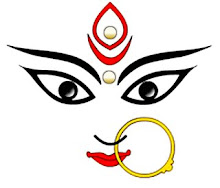நீங்கள் ஆண்டாளின் படத்தைப் பார்த்திருப்பீர்கள், முக்கியமாகத் தலையில் பெரிய கொண்டை அதைச் சுற்றி முத்துமாலை, அந்த முத்து மாலையின் ஒரு பகுதி கொண்டையின் உச்சியிலிருந்து தொங்கி ஊஞ்சல் ஆட அழகோ அழகு...மாறு வேடப் போட்டியிலும், கல்யாணங்களில் மணப்பெண்கள் சிலர்,
ஆண்டாள் வேஷம் போட்டுவது மிக சகஜம்.
அந்த அழகிய ஆண்டாளின் மார்கழி வைபவங்களும், திருப்பாவையும் இப்போது இங்கே பார்க்கலாம்.
 |
| ஸ்ரீஆண்டாளும் மார்கழியும் |
மார்கழியும் ஸ்ரீ ஆண்டாளும்
"மாதங்களில் நான் மார்கழி" என்று கீதையில் அருள்கிறார் ஸ்ரீகிருஷ்ண பரமாத்மா. நாம் குறிப்பிடும் ஓர் ஆண்டு என்பது தேவர்களுக்கு ஒரு நாள். அந்த நாளின் அதிகாலைப் பொழுது ---- மார்கழி. தேவர்களது
பிரம்ம முகூர்த்த காலமாகிய மார்கழியில், இறைவனை வழிபட்டால், சகல நன்மைகளும் உண்டாகும் எங்கின்றன சாஸ்திரங்கள். எனவேதான் ஆண்டாளும் மார்கழி மாதத்தைத் தேர்ந்தெடுத்து
" திருப்பாவை
நோன்பு" ஏற்றாள். ஆண்டாளின் அவதாரத் தலமான ஸ்ரீவில்லிபுத்தூரில் இந்த மார்கழி மாதத்தில் நடைபெரும் திருப்பாவைத் திருவிழா சிறப்பு வாய்ந்தது.
திருப்பள்ளியெழுச்சி:
அதிகாலை நேரத்தில், திருப்பள்ளியெழுச்சி, திருப்பல்லாண்டு மற்றும் திருப்பாவை பாசுரங்கள் ஆண்டாள் முன்பாக பாடப்படுகிறது. அதன் பிறகு, காலைநேர விஸ்வரூப தரிசனம் முடிந்தவுடன், ஸ்ரீஆண்டாளுக்கு
நடைபெறும் ஆராதனைகள் பக்தர்களின் உள்ளங்களைக் கொள்ளை கொண்டவை.
அமுது நைவேத்தியம் செய்யப்படும்போத, திருப்பாவையில் வரும்
"சடாரைவெல்லும் சீர் கோவிந்தா" என்ற பாசுரம் பக்தர்களால் உணர்ச்சிகரமாகப் பாடப்படும். பிறகு, தீர்த்தம், சடாரி ஆகியவற்றுடன் பிரசாதம் வழங்கப்படும். குளிர் மிகுந்த அந்த அதிகாலை நேரத்தில்.....ஸ்ரீகருடாழ்வார், ஸ்ரீஆண்டாள் சமேதராக எழுந்தருளும் ஸ்ரீரங்கமன்னாரை திருப்பாவை பாடி வணங்கும்போது மனதுக்குக் கிடைக்கும் பரவசமே தனிதான்.
 |
| ஸ்ரீஆண்டாள் உற்ஸவம் |
மார்கழி நிராட்ட உற்ஸவம்:
மார்கழி மாதம் 23ஆம் தேதி இரவு தொடங்கும் இந்த ஆண்டாள் நீடாட்ட உற்ஸவம், தை மாதப்பிறப்பு வரைக் கொண்டாடப்படும். மார்கழி 22ஆம் தேதி இரவு, "பிரியா விடை" வைபவம் நடைபெரும். ஸ்ரீவடபெருங்கோயிலுடையான் சந்நிதிக்கு எழ்ழுந்தருளும் ஆண்டாளுக்கு, அங்கே மகா மண்டபத்தில் தனியாக திருமஞ்சனம் [அபிஷேகம்] நடக்கும். பிறகு, பக்தர்கள் மலை மழை பொழிய, வேத கோஷம் முழங்க.... புஷ்பக்கொண்டை அலங்காரத்துடன், மூலஸ்தானத்துக்கு ஸ்ரீஆண்டள் அழுந்தருள்கிறாள். தொடர்ந்து, வடபத்ரசாயி பெருமாளுடன் சேர்ந்து காட்சிதரும் ஆண்டாளுக்கு திருவாராதனம் எனப்படும் பூஜை நடைபெறும். பிறகு சந்நிடியில் திரை போடப்படும். திருப்பாவை நோன்பு ஏற்க வடபெருங்கோயிலுடைனிடம் ஆண்டாள் அங்கே அனுமதி வேண்டுவதாக ஐதீகம். சிறிது நேரத்துக்குப் பிறகு, திரை நீக்கப்ப்ட்டு, அரையர் ஸ்வாமியால்...
"மார்கழித் திங்கள் மதிநிறைந்த நன்னாளால்
நீராடப் போதுவீர் போதுமினோ நேரிழையீர்
சீர்மல்கும் ஆய்ப்பாடிச் செல்வச் சிறுமீர்காள்
கூர்வேல் நெடுந்தொழிலன் நந்தகோபன் குமரன்
ஏரார்ந்த கண்ணி யசோதை இளஞ்சிங்கம்
கார்மேனி செங்கண் கதிர்மதியம் போல்முகத்தான்
நாராயணனே நமக்கே பறை தருவான்
பாரோர் புகழப் படிந்தேலோர் எம்பாவாய்....
என்ற திருப்பாவை முதல் பாசுரத்துக்கு விளக்கம் சொல்லப்படும். திருப்பாவையின் மற்ற பாசுரங்களும் சொல்லப்படும். காலை வேளையில், மக்களுக்கான தரிசனம் முடிநு, ஸ்ரீ ஆண்டாள் பெரியாழ்வார் சந்நிதி
வாசலை அடைகிறாள். அப்போது அரையர் ஸ்வாமி திருப்பல்லாண்டு பாடுவார்.
நீராட்ட உற்ஸவத்தின் ஒவ்வொரு நாளும், தங்கப் பல்லக்கில் வடபெருங்கோயிலின் ராஜகோபுர வாசலில் ஸ்ரீ ஆண்டாள் எழுந்த்ருள, "நாள்பாட்டு வைபவம் நடைபெறும் - ஒவ்வொரு நாளும் அந்த நாளுக்கான திருப்பாவைப் பாடல் பாடப்படுவதே இந்த நிகழ்ச்சி.
"மாலே! மணிவண்ணா! மார்கழி நீராடுவான்
மேலையார் செய்வனகள் வேண்டுவன கேட்டியேல்
ஞாலத்தையெல்லாம் நடுங்க முரல்வன
பாலன்ன வண்ணத்து உன் பாஞ்சசன்னியமே
போல் வன சங்கங்கள் போய்ப்பா டுடையனவே
சாலப்பெரும் பறையே பல்லாண்டிசைப்பாரே
கோல விளக்கே கொடியே விதானமே
ஆலி னிலையாய்! அருளேலோ ரெம்பாவாய்.
இந்த "மாலே மணிவண்ணா".....பாசுரத்தை ஸ்ரீ ஆண்டாளே சொல்வதாக ஐதீகம். இந்தப் பாடல் "ஆலி இலையாய் அருளேலோ எம்பாவாய்" என்று முடிவுறும் சம்ஸ்கிருதத்தில் "வட விருட்சம்" என்றால் ஆலமரம் என்றும் பொருள். ஆக....."வடபத்ரசாயி " என்பதையே, " ஆலின் இலையாய் " என்று அழகுத் தமிழில் ஆண்டாள் கூறுகிறாள் போலும்!!
ஸ்ரீஆண்டாள் நீராட்ட உற்ஸவத்தின் 2- ஆம் நாள் - கள்ளழகர் திருக்கோலம். 3-ஆம் நாள்- கண்ணன் கோலம். 4-ஆம் நாள் - முத்தங்கி சேவை. 5-ஆம் நாள் - பெரியபெருமாள் கோலம். 6ஆம் நாள் - மஹாராணியாக
அமர்ந்த கோலம். 7- ஆம் நாள் - தங்க கவச சேவை.... என சிறப்பு தரிசனம் உண்டு.
 |
| ஸ்ரீஆண்டாள் |
எண்ணைய் காப்பு வைபவம்:
திருமுக்குளம் கரையில் உள்ள நீராட்ட மண்டபத்தில், மாலை 3 மணிக்கு ஆண்டாளுக்கு "எண்ணைய் காப்பு" வைபவம் நடைபெரும். நெற்றிச்சுட்டி, தலை நாகர், தங்க ஜடை, சூரிய சந்திரர், ராக்கொடி ஆகிய தலை அலங்காரத்துடன் சவுரி தரித்து கோதா ராணியாக அமர்ந்த நிலையில் காட்சி தரும் ஆண்டாளின் அழகுக் கோலத்தைத் தரிசிப்பது பக்தர்கள் செய்த பாக்கியம்.
பிறகு, தலையில் அணிந்துள்ள ஆபரணங்களை ஒவ்வோன்றாக எடுத்து, தலையை கோதி, சிடுக்கு நீக்கி சுகந்த தைலம் சாத்துவர். இவ்வாறு, மூன்று முறை எண்ணை காப்பு சாற்றி, சவுரியை பெரிய கொண்டையாக முடித்து மலர் மாலைகள் அணிவிப்பர். இதனை தொடர்ந்து, "பத்தி உலாதுதல்" வைபவம்
முடிந்து நீராட்ட வைபவம். அப்போது சங்க நிதி, பத்ம நிதி, மற்றும் ஆயிரம் துளைகள் கொண்ட வெள்ளித் தாம்பாளம் கொண்டு, மஞ்சள் மற்றும் திரவியப் பொடிகளால் அபிஷேகம். முடிவில் தங்கக் குடத்தால் அபிஷேகம் செய்யப்படும்.
இரவு, ஒவ்வொரு நாளும் ஒவ்வொரு வாகனத்தில், ஸ்ரீவடபத்ரசாயி சந்நிதிக்கு எழுந்தருளி, தனது சந்நிதி திரும்புகிறாள் ஆண்டாள்.
எல்லா வைணவத் தருக்கோயில்லளிலும் "கூடாரை வல்லி" வைபவம் மார்கழி 27-ஆம் நாள் கொண்டாடப்படும். ஆனால், ஸ்ரீவில்லிபுத்தூரில் மட்டும் தை 1-ஆம் தேதி கொண்டாடப்படுகிறது. ஸ்ரீஆண்டாள் சந்நிதியில் ஆண்டாளின் சிம்மானத்தில், ஸ்ரீதேவி-பூதேவியுடன் ஸ்ரீபெரிய பெருமாள் எழுந்தருள ...அவருடன் ஸ்ரீஆண்டாள், ரங்கமன்னார், கருடாழ்வார் மற்றும் ஆழ்வார் -- ஆச்சார்யர்களும் எழுந்தருளி...
"கூடாரை வெல்லும் சீர் கோவிந்தா" முதலான திருப்பாவைப் பாடல்கள் பாடப்படும். அப்போது, "அக்கார அடிசல்" நைவேத்தியம் ஆக்கி, பிரசாதமாக தரப்படும். மறுநாள், தந்தையாகிய பெரியாழ்வார் சந்நிதியில் ஸ்ரீஆண்டாள் அழுந்தருளி " கணு வைபவம்" நடைபெறும்.
திவ்விய பிரபந்த உற்ஸவம்:
இங்கேயும் பகல் பத்து- ராப்பத்து உற்ஸவம் சிறப்பாகக் கொண்டாடப் படுகிறது. முதல் நாள் - ஸ்ரீஆண்டாள் தன் இல்லத்துக்குச் செல்லும் "பச்சை பரத்தல்" வைபவம் நடைபெறுகிறது. பெரியாழ்வாரின் வம்சத்தில் வந்து வேதபிரான் பட்டர் இல்லம். இங்கே சந்நிதித் தெருவில் உள்ளது. இங்கு வரும் ஆண்டாள், பச்சைக் காய்கறிகள் பரப்பி வைக்கப்பட்டிருப்பதை கண்டுகளிக்கிறாள். பிறகு, இந்த இல்லத்தில் செய்யப்பட்ட திரட்டுப்பால், மணிப்பருப்பு முதலான நைவேத்தியங்களை ஏற்று, பெரிய பெருமாள் சந்நிதிக்குச் செல்வாள்.
பகல் பத்து - ராப்பத்து எல்லா நாட்களும் அரையர் சேவை நடைபெரும். ராப்பத்து உற்ஸவத்தின் நடுவில்.....ஸ்ரீஆண்டாள், அவளின் வலப்புறம் ஸ்ரீபெரியபெருமாளும், இடப்புறம் - ஸ்ரீ ரங்கமன்னாரும் எழுந்தருள்வது
கண்கொள்ளாக் காட்சி!!
 |
| ஸ்ரீஆண்டாள் |
கோயில் அண்ணன் வைபவம்:
அரங்கனை அடையும் தனது விருப்பம் நிறைவேறினால், நூறு தடாவில் அக்கார அடிசிலும் வெண்ணெயும் கள்ளழகருக்கு சமர்ப்பிப்பதாக [நாச்சியார் திருமொழியில் - "நூறு நறும்பொழில்" பாசுரத்தில்] பிரார்த்திக்கிறாள் ஆண்டாள். திவ்விய தேசங்களை தரிசித்து வந்த ஸ்ரீராமானுஜர், கள்ளழகர்கோயிலுக்கும் வந்தார். ஆண்டாளின் பிரார்த்தனை அவர் நினைவுக்கு வந்தது. அழகருக்கு 100 தராவில் அக்கார அடிசிலும்
வெண்ணெயும் சமர்ப்பித்தார். பிறகு, அவர் ஸ்ரீவில்லிப்புத்தூர் கோயிலுக்கு வந்தபோது, "விக்கிரக வடிவான ஆண்டாள், வாரும் என் அண்ணலே" என்று எதிர்கொண்டு அழைத்தாளாம்!! அன்று முதல், "கோயில் அண்ணன்" என்ற சிறப்புப் பெயர் ஸ்ரீராமானுஜருக்கு ஏற்பட்டது. அதனால், ஸ்ரீஆண்டாளை வாழ்த்தும் வாழ்திருநாமப் பாடலில் ஒரு வரி " பெரும்புதூர் மாமுனிக்கு பின்னானாள் வாழியே" என்று வருகிறது.
அரையர் சேவை:
ஸ்ரீரங்கம், ஆழ்வார் திருகரி மற்றும் ஸ்ரீவில்லிப்புத்தூர் தலங்களில் இந்த அரையர் சேவை நடைபெருகிறது.
ஆழ்வார் பாசுரங்களை இயல், இசை, நாடகம் என முத்தமிழிலும் சொல்வார்கள் அரையர்கள். முதலில் இசையாகப் பாடியும், பிறகு அபிநயம் செய்து விளக்கியும், முடிவில் விளக்கவுரை தருவதும் அரையர்
சேவையாகும். இங்கு நாதமுனிகளின் வம்சத்தில் வந்த 80 வயதைக் கடந்த அரையர் ஸ்ரீ ஊ.வே. ஸ்ரீநிவாச ரங்காச்சார்யார், அவரின் மகங்கள் மற்றும் பேரன் ஆகியோர் இதை மிகச் சிறப்பாக செய்து வருகிறார்கள்.
 |
| ஸ்ரீஆண்டாள் |
பது மூத்தோர் சொல். எனவே திருமணம் ஆகாத கன்னிப் பெண்கள், இந்த மார்கழி மாதம் நோன்பிருந்து ஆண்டவனை வழிபடுவார்கள யானால், விரைவில் நல்ல கணவனை அடைவார்கள் என்பது திண்ணம். கண்ணபரமாத்மாவைகணவனாகஅடைய வேண்டும் என்பதற்காக காத்தியாயனியை[துர்கையின்ஒரு அம்சம்] பிருந்தாவனகோபிகைகள், நோன்பிருந்து பூஜித் துள்ளனர்.இது பற்றிய குறிப்பு, ஸ்ரீமத்பாகவத புராணத்தில் உள்ளது.
"விரதமிருந்து நல்ல கணவனை அடைவது' என்பது பாவை நோன்பின் புறப்பொருள். ஆண், பெண் என்னும் இருவகை ஜீவாத்மாக்களுமே பக்தி செய்து பரமனுடன் கலக்க அறிவுறுத்துவதே இந்த நோன்பின் அகப்பொருள். இக்கருத்தை உள்ளீடாகக் கொண்டு உருவானவையே மாணிக்கவாசகரின் திருவெம்பாவையும், ஆண்டாள் அருளிய திருப்பாவையும்!
 |
| ஸ்ரீஆண்டாள் சேவை |
திருப்பாவை, திருவெம்பாவை இரண்டிலுமே பெண்களை நித்திரையிலிருந்து எழுப்புகின்ற வகையில் பாடல்கள்அமைந்துள்ளன. "மாயை' என்னும் தூக்கத்தில் தன்னை மறந்து கிடக்கும் ஜீவாத்மாக்கள், விழிப்புணர்வு பெற்ற பரமாத்மாவை அடையவேண்டும் என்பதே ஆண்டாளுக்கும், மாணிக்கவாசகருக்கும் நோக்கம். இந்துமதத்தின் இரு கண்களாக சைவமும், வைணவ மும்விளங்கிவருகின்றன.எனவே மார்கழி மாதத்தில் அனைவரும், தங்கள் மரபுக்கேற்ப திருவாசகத்தையோ, திருப்பாவையையோ, அல்லது இரண்டையுமோ பாராயணம் செய்து பரமனின் அருள் பெறுக!
















































